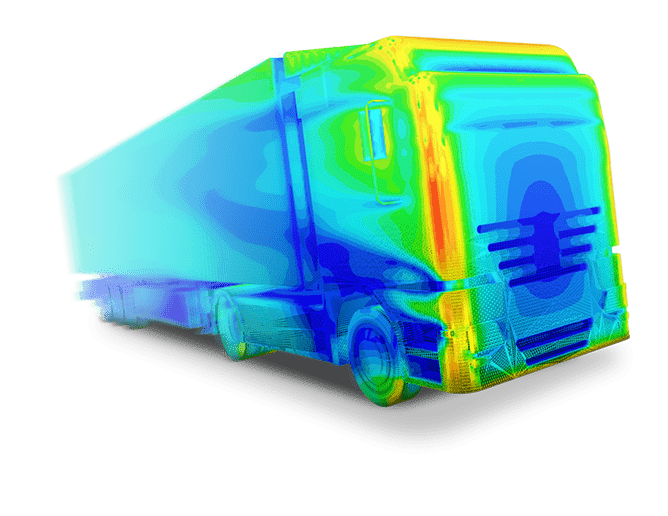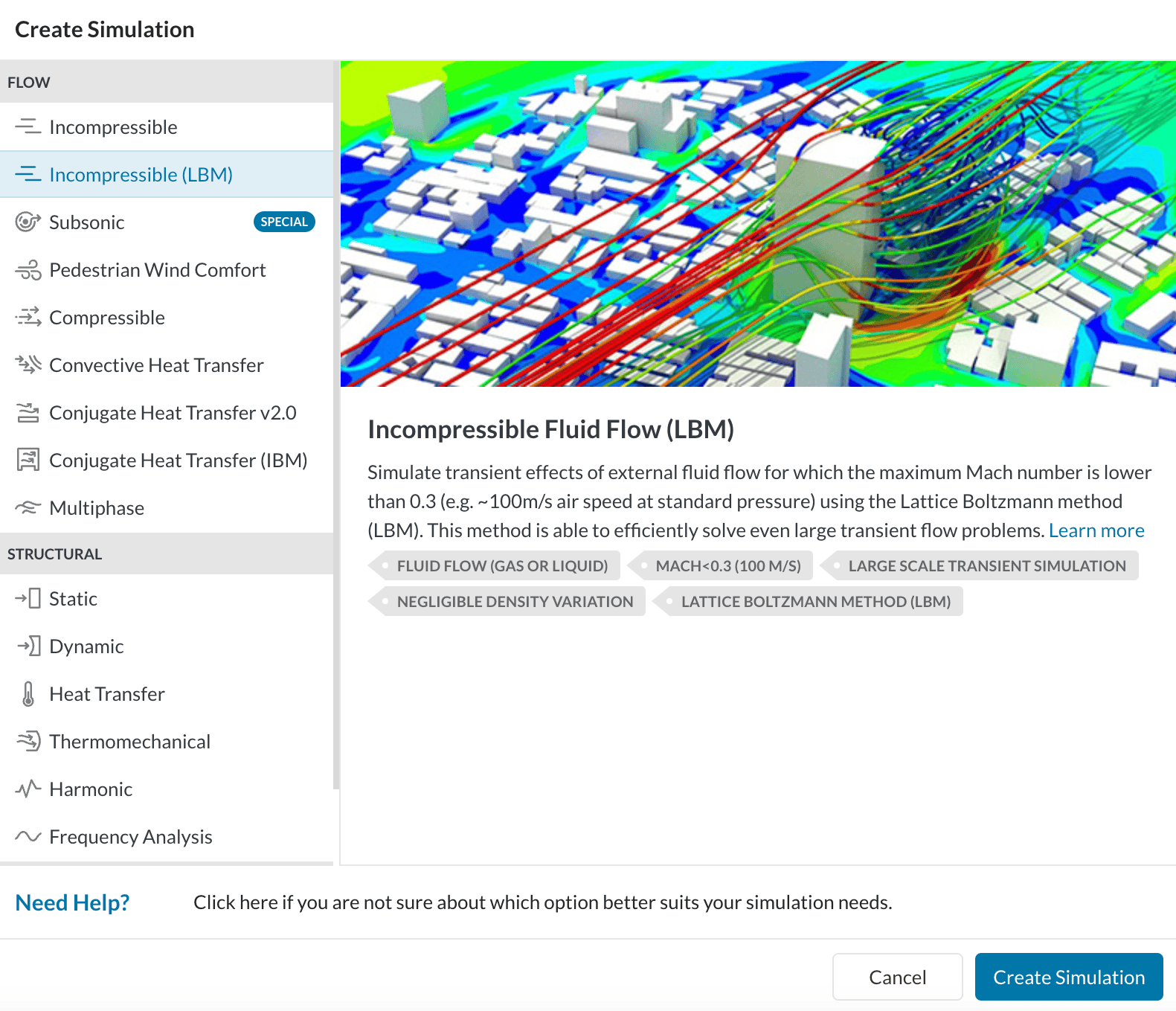Documentation
The Lattice Boltzmann Method (LBM) is a computational fluid dynamics (CFD) method that represents a paradigm shift in how simulations are conducted, enabling a broad spectrum of applications previously out of reach for traditional Navier-Stokes solvers. Whether you’re a seasoned CFD professional or a beginner keen to learn more, understanding the LBM is vital in the modern simulation landscape.
The application of LBM has grown substantially due to its capabilities in handling complex flow scenarios and intricate geometries. It has been used across various sectors, including aerospace, automotive, and architecture. Simulation platforms such as SimScale have further expanded LBM’s application by providing tools for practical, real-world applications.
In this article, we dive into the world of LBM, and we explore the ins and outs of this numerical method and how it is applied in different applications using SimScale’s cloud-native CFD simulation platform.
The lattice Boltzmann method (LBM) is a numerical method that simulates fluid dynamics on a macroscopic scale based on kinetic equations formulated on a mesoscopic scale [1]. More precisely, it is “a parallel and efficient algorithm for simulating single-phase and multiphase fluid flows and for incorporating additional physical complexities” [2]. It is particularly useful for modeling complex boundary conditions and multiphase interfaces.
Originating from the lattice gas automata (LGA) developed in the 1980s, the Lattice Boltzmann Method (LBM) emerged as a robust contender to conventional computational fluid dynamics (CFD) approaches. Born from the need for cutting-edge and efficient simulation techniques, LBM transitioned from LGA’s discrete and binary model to a model grounded in continuous distribution functions. This shift not only augmented its accuracy but also broadened its scope of application. Through the years, LBM’s swift evolution and versatility have cemented its position as a leading choice for fluid simulations, particularly when dealing with complex geometries and flow conditions.
Another interpretation of the Lattice Boltzmann method can be represented in a discrete-velocity Boltzmann equation. The Boltzmann equation was derived by Ludwig Eduard Boltzmann (1844-1906), who was an Austrian physicist and philosopher famously known for his works in statistical mechanics, predicting the properties of atoms and determining the physical properties of matter, such as viscosity, diffusion, and thermal conductivity.
What defines LBM is its lattice framework and discrete velocity sets. Distinct from traditional CFD approaches, LBM operates on a discrete lattice where each node stands as a computational point, boasting an associated distribution function that reflects the likelihood of particle groups moving in specific directions or velocities.
When discussing the application of LBM, it’s essential to highlight the method’s adaptability and strength. Unlike the traditional Navier-Stokes-based methods, which may experience limitations when addressing complex geometries like porous materials, LBM shines. Specifically, LBM’s intrinsic discrete framework provides it with the ability to efficiently simulate flows within intricate structures, making it a favorable choice for a range of complex simulations.
Fluid dynamics, in its essence, relies heavily on mathematical models to describe and predict fluid behaviors. LBM is no different, offering a unique and sophisticated mathematical framework.
While conventional fluid dynamics techniques treat space and velocity fields as continuous, LBM adopts a distinct, discretized approach. Within LBM, the term ‘lattice’ refers to a spatial grid where each node or point corresponds to a specific location. Velocities, in a similar vein, are not continuous but discretized into a set number. These discrete velocities are often expressed using the ‘DnQm’ notation: ‘n’ indicates spatial dimensions, and ‘m’ denotes the count of discrete velocities. Such a method of discretization simplifies the computational process, especially in intricate geometries.
LBM operates fundamentally on two key processes: collision and streaming. In the collision phase, particle distributions at each lattice node interact, resulting in a reshuffling of particle velocities, ensuring both mass and momentum are conserved.
The subsequent streaming phase sees particles advancing to neighboring nodes, guided by their velocities post-collision. It’s through these localized (collision) and overarching (streaming) interactions that LBM effectively captures the intricacies of fluid behaviors.
Central to LBM is its foundational equation, which draws from the Boltzmann equation in kinetic theory. In essence, this equation examines the evolution of a particle’s distribution function—or the likelihood of its presence—over time as influenced by collisions. When integrated with the elements of discretization and the delineated collision-streaming processes, the LBM offers a rigorous and flexible depiction of fluid dynamics, often matching or even exceeding the capabilities of conventional CFD methods.
The governing equation of LBM can be expressed as follows [3][4]:
$$ \frac{\partial{f_i}}{\partial{t}}+c_i \nabla{f_i}=\frac{1}{\tau}\left(f_i^{eq}-f_i\right) $$
where the left side of the equation represents the streaming phase, while the right side represents the collision phase.
$$ f_i(r+c_i\Delta{t}, t+\Delta{t})=f_i(r, t)+\frac{\Delta{t}}{\tau}\left[f_i^{eq}(r, t)-f_i(r, t)\right] $$
The Lattice Boltzmann Method has redefined the landscape of computational fluid dynamics (CFD) in various engineering sectors. Unlike traditional Navier-Stokes-based simulations, LBM offers a mesoscopic approach, focusing on the particle interactions at a microscopic level. This distinctive approach brings forth several advantages, making LBM a game-changer for many applications:
LBM assists in evaluating wind loads on structures, optimizing ventilation systems in buildings, and simulating urban microclimates. These insights drive sustainable and resilient infrastructure development.
LBM offers unparalleled accuracy for understanding phenomena like sediment transportation or pollutant dispersion in natural water bodies. This assists researchers in formulating environment-friendly strategies and interventions.
LBM’s ability to delve into the microscopic scale allows for accurate simulations in microfluidic devices. This has wide-ranging implications in biotechnology, where precise control over minute fluid volumes is essential.
Understanding turbulent flows and their interaction with aircraft surfaces is paramount in aerospace engineering. LBM provides a detailed insight into such intricate flow dynamics, ensuring optimal design and safety measures.
In reservoir simulations and pipeline flow analysis, the mesoscopic perspective of LBM plays a pivotal role. It aids in maximizing extraction efficiency and ensures the safe transportation of resources.
The automotive sector benefits immensely from LBM, particularly when evaluating external aerodynamics. Through precise simulations, manufacturers can achieve fuel efficiency and enhance cabin comfort.

As powerful as LBM is, its full potential is only realized when applied through cutting-edge platforms. That’s where SimScale steps in.
Simscale’s Incompressible LBM analysis is specifically designed for large transient external aerodynamics simulations, ideal when the Mach number is below 0.3. Developed by Numeric Systems GmbH’s Pacefish®, this GPU-optimized solver ensures rapid yet accurate simulations that can be run in parallel on the SimScale cloud-native platform, shortening the run time from weeks to hours and less.
The platform emphasizes the significance of CAD preparation, ensuring that models are optimized for LBM simulations. Boundary conditions are predefined, simplifying the setup process, while the meshing approach is tailored for LBM, using a cartesian background mesh comprising only cube elements. For a step-by-step guide, consult the Incompressible LBM Analysis Guide.
Simscale’s LBM is adept at managing diverse CAD types, thus overcoming common geometry challenges. The integration of the Pacefish® solver introduces a wide array of turbulence modeling options. A standout feature is the Reynolds scaling factor, which applies scaling to full-scale geometry, effectively replicating wind tunnel conditions. Another feature is wall treatment, in which the Pacefish® solver shows higher flexibility with wall functions than FVM codes. This feature renders the SimScale LBM implementation suitable for industrial problems thanks to the reduced mesh requirements. The platform also offers a plethora of result exportation methods, ensuring users can extract the insights they need.
A testament to Simscale’s commitment to cutting-edge solutions, the GPU-based LBM solver, optimized for the parallel architecture of GPUs, excels in virtual wind tunnel analyses. Its applications span from urban planning to automotive aerodynamics. The solver’s precision is further underscored by projects that align its results with wind tunnel data.

Here’s how one can use LBM within the SimScale platform:
One of the practical examples provided by SimScale is a wind analysis over a CAD model of a city. This tutorial leverages the LBM to run the simulation. It covers everything from preparing the CAD model to setting up the simulation, meshing, running the simulation, and analyzing the results. Such simulations can be crucial for urban planning, architectural design, and understanding pedestrian wind comfort. They can influence decisions related to building orientation, placement of green spaces, and even traffic flow.
Several projects on SimScale’s platform utilize the LBM for various applications. Here are a few notable ones:
This project focuses on understanding the aerodynamics of an LMP1 race car using LBM, crucial for optimizing performance on the racetrack.
An analysis of the aerodynamic properties of the Tesla Cybertruck, providing insights into its design efficiency.
A wind analysis over the Toronto Four Seasons area, helping in urban planning and architectural considerations.
This project uses LBM to study the natural ventilation in a large commercial space, aiding in HVAC design and energy efficiency.
An essential study for urban planners, this project uses LBM to analyze wind comfort levels in pedestrian areas in London.
For a deeper dive into these projects and to explore more, you can visit the SimScale Project Library. By following the steps outlined above and exploring the provided real-world examples, users can effectively harness the power of the LBM within SimScale for advanced fluid dynamics simulations.
In the ever-evolving space of computational simulations, platforms need to be both technologically advanced and user-friendly. Here’s how SimScale elevates LBM’s capabilities for diverse engineering applications:
One of the most distinctive features of SimScale is its cloud-based architecture. This means no more worries about high-end hardware requirements. With SimScale, you can run intricate LBM simulations from any device, anytime, anywhere. The cloud-based approach also facilitates effortless collaboration between teams, streamlining the simulation workflow.
While LBM can be conceptually challenging, SimScale has ensured that the user experience remains intuitive. With its user-friendly interface, engineers can set up, run, and analyze simulations without a steep learning curve. This accelerates the adoption of LBM early in the design cycle and across industries.
The true value of a simulation lies in the insights drawn from it. SimScale offers a comprehensive suite of post-processing tools. Visualizing flow patterns, analyzing turbulence statistics, or evaluating boundary conditions, everything becomes more intuitive and detailed.
SimScale’s extensive library encompasses a wide array of materials and models. Whether you’re looking to simulate the flow of a fluid in a microchannel or the turbulent wind patterns around a skyscraper, SimScale has got you covered.
For those new to LBM or looking to deepen their understanding, SimScale offers a wealth of resources. From webinars to tutorials, validation cases and in-depth documentation, the platform ensures that users are well-equipped to maximize the benefits of LBM.
SimScale’s pricing model is tailored to offer maximum value. Whether you’re a startup venturing into product design or an established firm looking to enhance your R&D, SimScale provides a cost-effective solution to harness the full potential of LBM.
As computational power continues to grow and becomes even more accessible, we can anticipate more intricate and large-scale simulations being conducted using LBM. SimScale, with its commitment to continuous innovation, is poised to play a pivotal role in this future.
The platform’s emphasis on user-friendliness, accessibility, integration capabilities, and scalability suggests that LBM applications will not only grow in number but also in complexity, catering to a wider range of real-world scenarios.
By enabling cloud-based LBM simulations, SimScale ensures that engineers, developers, and researchers can leverage this powerful method, underscoring its significance in today’s digital age. For SimScale users, this means having a cutting-edge tool at their fingertips, ready to tackle the challenges of modern engineering.
References
Last updated: July 2nd, 2025
We appreciate and value your feedback.
What's Next
What is Large Eddy Simulation (LES) in CFD?Sign up for SimScale
and start simulating now